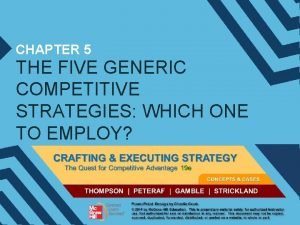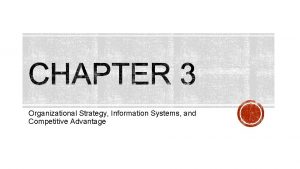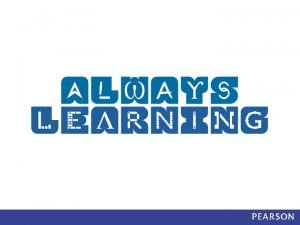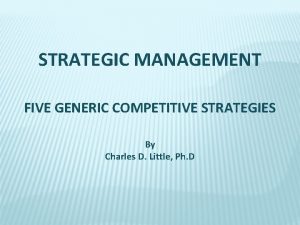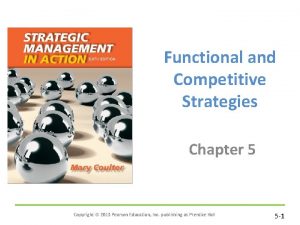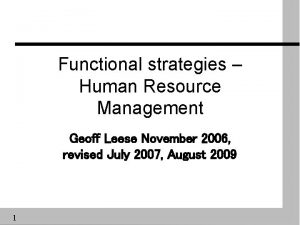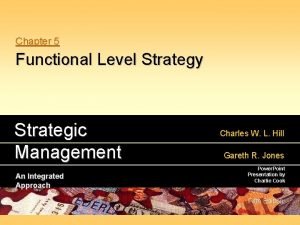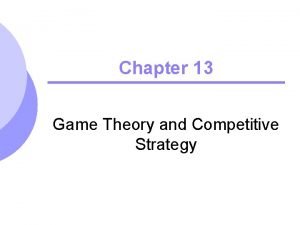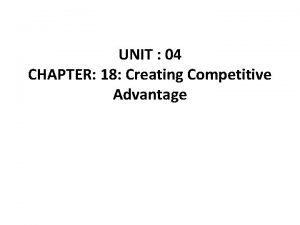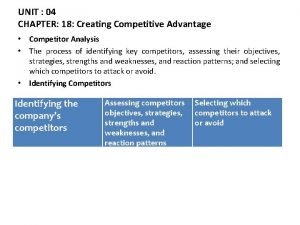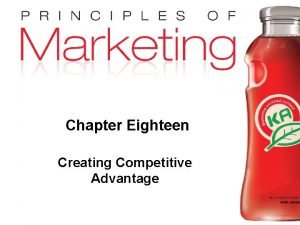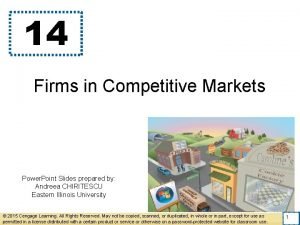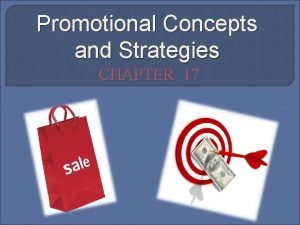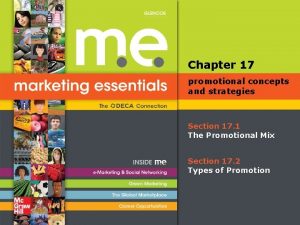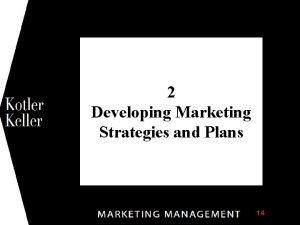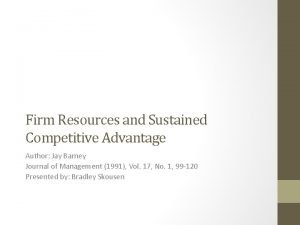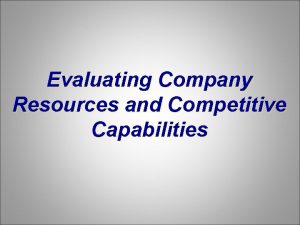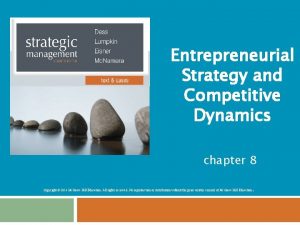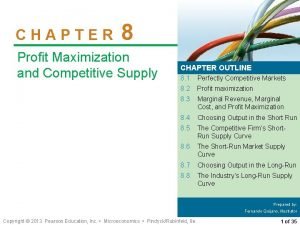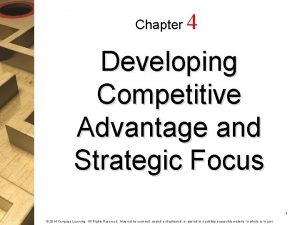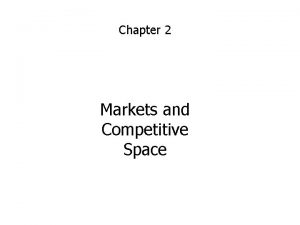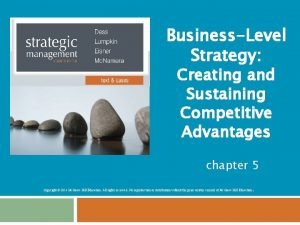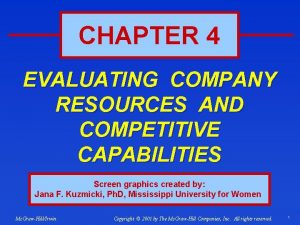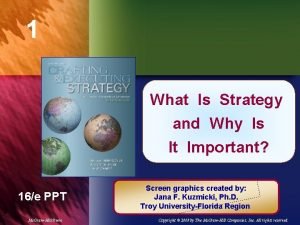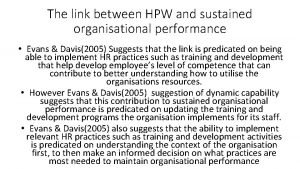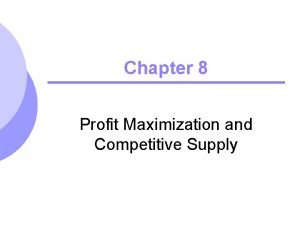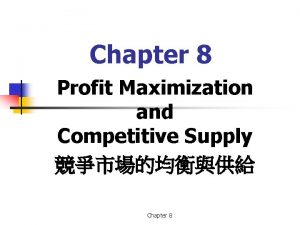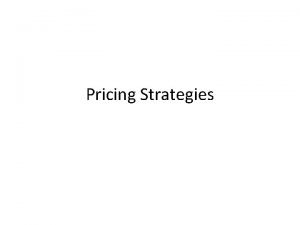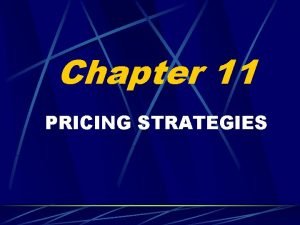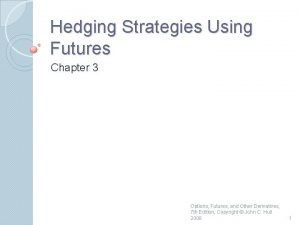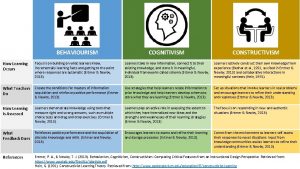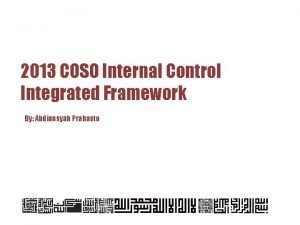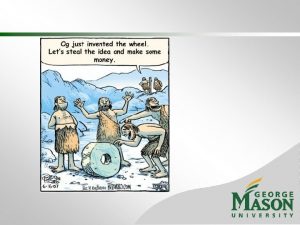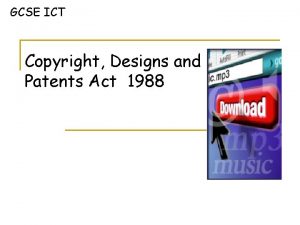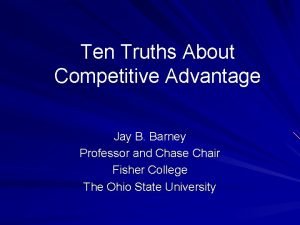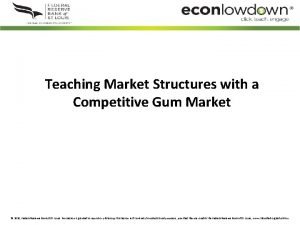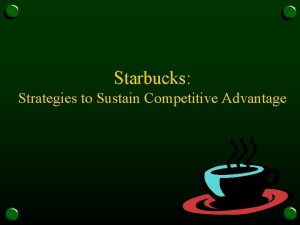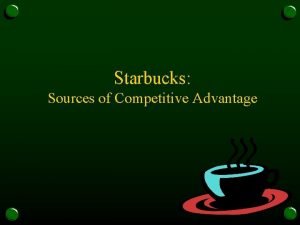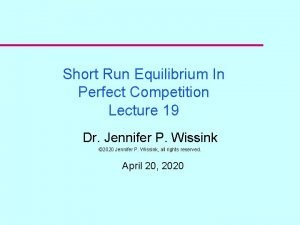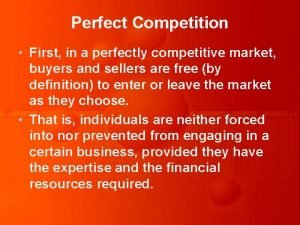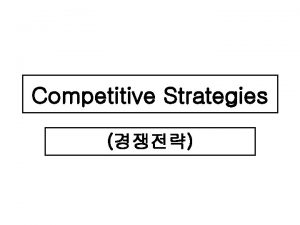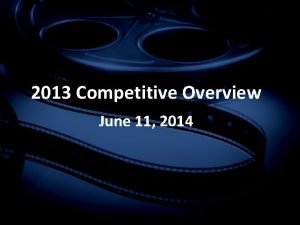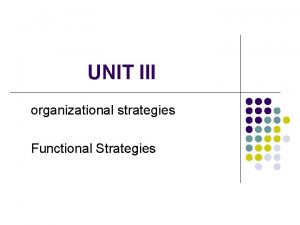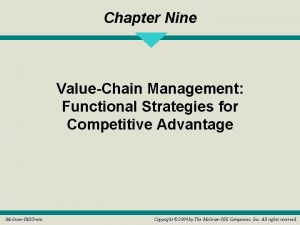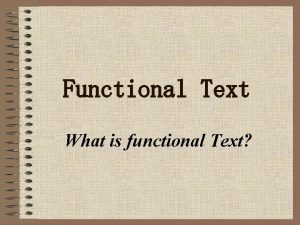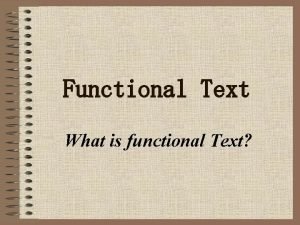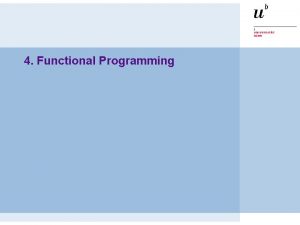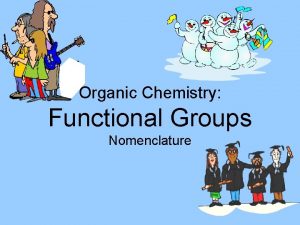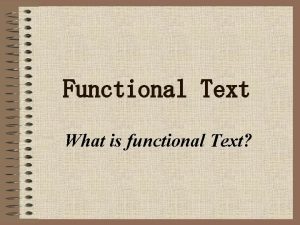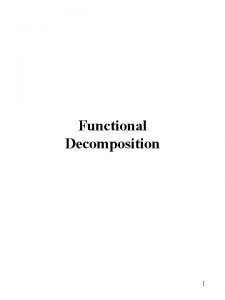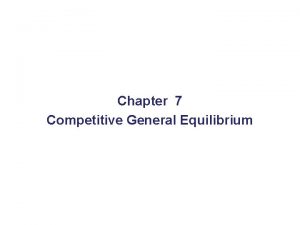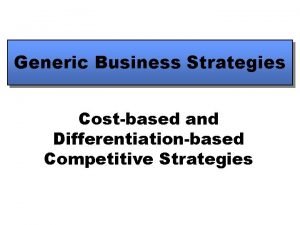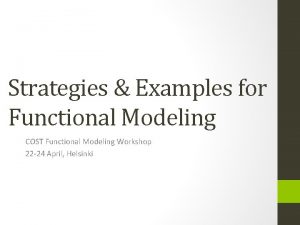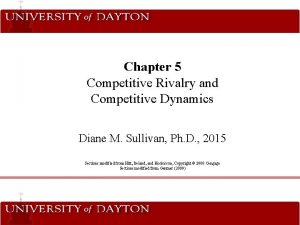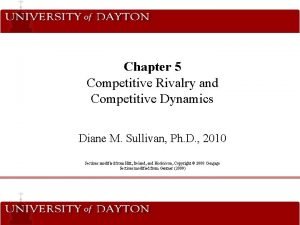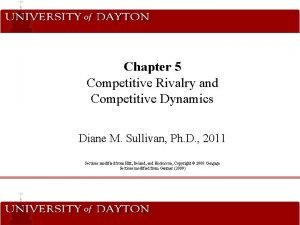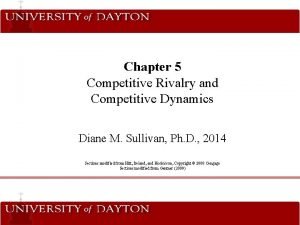Functional and Competitive Strategies Chapter 5 Copyright 2013





























































- Slides: 61

Functional and Competitive Strategies Chapter 5 Copyright © 2013 Pearson Education, Inc. publishing as Prentice Hall 5 -1

Chapter Five Learning Outcomes 5. 1 Describe the functional strategies an organization needs and explain how those strategies are implemented and evaluated. 5. 2 Explain competitive advantage and what it implies. 5. 3 Describe the different competitive strategies. 5. 4 Discuss how competitive strategies are implemented and evaluated. Copyright © 2013 Pearson Education, Inc. publishing as Prentice Hall 5 -2

Learning Outcome 5. 1 • Describe the functional strategies an organization needs, and explain how those strategies are Implemented and evaluated Copyright © 2013 Pearson Education, Inc. publishing as Prentice Hall 5 -3

Copyright © 2013 Pearson Education, Inc. publishing as Prentice Hall 5 -4

Strategic Management in Action: Process • Even though the chapters leading up to this have explored several aspects of strategic management in action, the process may still be confusing • The process is like trying to complete a three dimensional jigsaw puzzle – The completed “puzzle” would be the overall corporate direction and goals set by the organization’s top management Copyright © 2013 Pearson Education, Inc. publishing as Prentice Hall 5 -5

What Happens after SWOT Analysis? • At this point, decision makers have information about the positive and negative aspects of both the external and internal environments – If strengths in functional areas can be exploited against the external environment, competitive advantages can emerge and high levels of performance achieved Copyright © 2013 Pearson Education, Inc. publishing as Prentice Hall 5 -6

What Happens after SWOT Analysis? (cont’d) • If SWOT analysis points to threats in the organization’s external areas or weaknesses in the internal areas, changes in functional strategies might be needed • Even if corporate or competitive strategies need to be changed, strategists base their decisions on resources, capabilities, and core competencies found in functional areas Copyright © 2013 Pearson Education, Inc. publishing as Prentice Hall 5 -7

Copyright © 2013 Pearson Education, Inc. publishing as Prentice Hall 5 -8

What Functional Strategies Does an Organization Need? • Functional Strategies: The Product – Product design strategies typically involve an organizations R&D functional area – Production includes an organization’s production/operations strategies – Marketing strategies are aimed at effectively and efficiently managing the two “Cs” customers and competitors Copyright © 2013 Pearson Education, Inc. publishing as Prentice Hall 5 -9

What Functional Strategies Does an Organization Need (cont. )? • Functional Strategies: The People – High-performance work practices are ones that lead to both high individual and high organizational performance – HR strategies reflect its commitment to and treatment of its employees. – Other strategies may address HR issues such as employee relations, job design, diversity efforts, workplace safety and health, and workplace misbehavior Copyright © 2013 Pearson Education, Inc. publishing as Prentice Hall 5 -10

Copyright © 2013 Pearson Education, Inc. publishing as Prentice Hall 5 -11

What Functional Strategies Does an Organization Need (cont. )? • Functional Strategies: The Support Process – Information Systems - strategic decisions include the choice of system technology and the choice of types of information systems needed. – Financial Systems - provide strategic decision makers with information about the organization’s financial transactions, accounts, and standing. Copyright © 2013 Pearson Education, Inc. publishing as Prentice Hall 5 -12

Learning Review: Learning Outcome 5. 1 • How does the work done in the functional areas support the creation of a competitive advantage? • What happens after the SWOT analysis is completed? • What are three functional concerns of organizations? • What strategies are important to each of those functional concerns? Copyright © 2013 Pearson Education, Inc. publishing as Prentice Hall 5 -13

Learning Outcome 5. 2 Explain What Competitive Advantage is and What it Implies • The key to strategic management, the challenge is getting and keeping competitive advantage – It is about doing something others cannot or doing it better (distinctive capability) – Or, the organization has something others do not (unique resource) Copyright © 2013 Pearson Education, Inc. publishing as Prentice Hall 5 -14

Understanding the Competitive Environment • What Is Competition? – – It’s when organizations battle or vie for some desired object or outcome like customers, market share, survey ranking, or needed resources Copyright © 2013 Pearson Education, Inc. publishing as Prentice Hall 5 -15

Copyright © 2013 Pearson Education, Inc. publishing as Prentice Hall 5 -16

Who Are Competitors? • There are three approaches to defining an organization’s competitors 1. Industry perspective – This identifies competitors as organizations that are making or selling the same or similar goods or services – These industries can be described according to the number of sellers and degree of differentiation; both affect competitive intensity Copyright © 2013 Pearson Education, Inc. publishing as Prentice Hall 5 -17

Who Are Competitors? (cont’d) 2. The market perspective – Believes that competitors are organizations that satisfy the same customer needs – The intensity of competition in the market perspective depends on how well customer needs are understood or defined and how well different organizations are able to meet those needs Copyright © 2013 Pearson Education, Inc. publishing as Prentice Hall 5 -18

Who Are Competitors? (cont’d) 3. The strategic groups concept – Is based on the idea that there are groups of firms competing in an industry with similar strategies, resources, and customers – In a single industry there will be several strategic groups depending on what is important to the customer – The strategic factors used to group competitors are not price and quality, but price and distribution strategy Copyright © 2013 Pearson Education, Inc. publishing as Prentice Hall 5 -19

Copyright © 2013 Pearson Education, Inc. publishing as Prentice Hall 5 -20

The Role of Resources and Distinctive Capabilities • Every organization has resources and capabilities, ever, not every organization effectively exploits those resources or capabilities or obtains the resources or capabilities it needs but doesn’t have. • Some organizations are able to put it all together, some are not. Copyright © 2013 Pearson Education, Inc. publishing as Prentice Hall 5 -21

From Competitive Advantage to Competitive Strategies • Competitive strategy - based on the competitive advantage(s) that the organization has been able to develop. Copyright © 2013 Pearson Education, Inc. publishing as Prentice Hall 5 -22

Learning Review: Learning Outcome 5. 2 • Is competition an issue for all organizations? • What is competitive advantage? • Compare and contrast the three approaches to defining competitors. • What role do resources and distinctive capabilities play in gaining competitive advantage? • Define competitive strategy. What’s the connection between competitive advantage and competitive strategy? Copyright © 2013 Pearson Education, Inc. publishing as Prentice Hall 5 -23

Learning Outcome 5. 3 Describe the Different Competitive Strategies • There may be numerous ways an organization competes – However, the number of competitive strategies is actually few – There are the traditional strategies and some contemporary perspectives Copyright © 2013 Pearson Education, Inc. publishing as Prentice Hall 5 -24

Traditional Approaches to Defining Competitive Strategy Miles and Snow’s Adaptive Strategies • Identified four strategic postures – Prospector – Defender – Analyzer – Reactor Copyright © 2013 Pearson Education, Inc. publishing as Prentice Hall 5 -25

Miles and Snow’s Adaptive Strategies • Prospector strategy – Is one in which the organization continually innovates by finding and exploiting new product and market opportunities – The competitive strength of this strategy is in the ability understand a wide range of rapidly changing environmental conditions, trends, and situations and create new products and services to fit this dynamic environment Copyright © 2013 Pearson Education, Inc. publishing as Prentice Hall 5 -26

Miles and Snow’s Adaptive Strategies – cont’d • Prospector Strategy (cont’d) – The effort is to continually innovate, develop, and test new products; as they look for new directions – This creates uncertainties for a prospector’s competitors, as they never know what to expect from the prospector – If the prospector can develop new products the market desires and is willing to pay for, it will have competitive advantage Copyright © 2013 Pearson Education, Inc. publishing as Prentice Hall 5 -27

Miles and Snow’s Adaptive Strategies – cont’d • Defender Strategy – Is used by organizations to protect current market share by emphasizing existing products and producing a limited product line – These firms have a well-established business they seek to safeguard and aggressively prevent competitors from taking market share from them – A defender succeeds by maintaining a competitive product line and making it hard for others to compete Copyright © 2013 Pearson Education, Inc. publishing as Prentice Hall 5 -28

Miles and Snow’s Adaptive Strategies – cont’d • Analyzer Strategy – This is a strategy of analysis and imitation – Analyzers watch for and copy the successful ideas of prospectors, thoroughly analyzing a business before jumping into it – They will systemically assess and evaluate whether their move is appropriate for them – The CEO of Gol Intelligent Airlines claims to have built profit from imitating Jet. Blue and Southwest Airlines Copyright © 2013 Pearson Education, Inc. publishing as Prentice Hall 5 -29

Miles and Snow’s Adaptive Strategies – cont’d • Reactor Strategy – Is characterized by the lack of a coherent strategic plan or apparent means of competing – Reactors simply react to environmental changes and make adjustments only when forced to do so by environmental pressures – Often, reactors are unable to respond quickly to perceived changes in the environment because they lack or are unable to exploit the resources or capabilities necessary Copyright © 2013 Pearson Education, Inc. publishing as Prentice Hall 5 -30

Porter’s Generic Competitive Strategies • Porter suggests it is important for an organization to have an appropriate competitive strategy. But, what is appropriate? – Porter suggests it is based on an organization’s competitive advantage that comes from one of two sources: having the lower costs in the industry or possessing significant and desirable differences from competitors Copyright © 2013 Pearson Education, Inc. publishing as Prentice Hall 5 -31

Porter’s Generic Competitive Strategies – cont’d • Another strategic factor is the scope of the product market in which the organization wishes to compete. The mix of these factors provides the basis for his generic competitive strategies – Cost leadership – Differentiation – Focus (niche) Copyright © 2013 Pearson Education, Inc. publishing as Prentice Hall 5 -32

Porter’s Generic Competitive Strategies – cont’d • Cost leadership strategy – Is low cost strategy, it is when a company strives to have the lowest costs in the industry and produces products for a broad customer base – The main goal is to have the lowest costs, not necessarily the lowest prices; so the effort is to have the lowest total unit costs in the industry Copyright © 2013 Pearson Education, Inc. publishing as Prentice Hall 5 -33

Porter’s Generic Competitive Strategies – cont’d • Cost leadership strategy (cont’d) – With the lowest costs, the leader can charge the lowest prices and still earn profits. If competition heats up and a price war breaks out, the cost leader is in a better position to withstand the fight and still earn profits – Because the cost leader seeks to keep costs low, efficiency in all areas is critical and resources, distinctive capabilities, and functional strategies are directed at that effort Copyright © 2013 Pearson Education, Inc. publishing as Prentice Hall 5 -34

Porter’s Generic Competitive Strategies – cont’d • Drawbacks of cost leadership strategy – Lowering costs too much and taking away its advantage – Competitors are easily able to imitate what the cost leader is doing – The focus on cost causes a failure to recognize changing customer tastes and needs – If what is done to reduce costs to produce or market a product fails to get customers to buy it Copyright © 2013 Pearson Education, Inc. publishing as Prentice Hall 5 -35

Porter’s Generic Competitive Strategies – cont’d • Differentiation Strategy – This is when a company competes by providing unique (different) products with features the customers value as different and are willing to pay a premium price for them – The main goal of the differentiator is to compete by providing goods or services that are truly unique and different in the eyes of the customers. If successful, the firm can charge a premium price Copyright © 2013 Pearson Education, Inc. publishing as Prentice Hall 5 -36

Porter’s Generic Competitive Strategies – cont’d • Differentiation Strategy (cont’d) – The premium price provides the profit incentive to compete on the basis of differentiation – To differentiate successfully, all capabilities, resources, and functional strategies must be aimed at isolating and understanding market segments and developing product features that are valued by customers in those segments Copyright © 2013 Pearson Education, Inc. publishing as Prentice Hall 5 -37

Porter’s Generic Competitive Strategies – cont’d • Differentiation Strategy (cont’d) – The differentiator will have broad and wide product lines – many models, features, price ranges – that enables the customer to perceive as unique and worth the extra price – This can be expensive and requires that costs are controlled to protect the price, but not to the extent it loses its value; competition is on the basis of difference and perceived value, not price Copyright © 2013 Pearson Education, Inc. publishing as Prentice Hall 5 -38

Porter’s Generic Competitive Strategies – cont’d • Differentiation Strategy (cont’d) – This strategy seeks to differentiate in as many market segments as possible – It also focuses on brand loyalty, which creates repeat purchases – Marketing and R&D are essential to this strategy, requiring resources and distinctive capabilities Copyright © 2013 Pearson Education, Inc. publishing as Prentice Hall 5 -39

Porter’s Generic Competitive Strategies – cont’d • Drawbacks of differentiation strategy – The need to remain unique to customers may be difficult if competitors are able to imitate and copy the successful features that have served to differentiate the product or services – If customers become price sensitive; which makes being unique no longer as valuable – Pottery Barn saw its unique products imitated and being sold for less by Restoration Hardware, Target, and Wal-Mart Copyright © 2013 Pearson Education, Inc. publishing as Prentice Hall 5 -40

Porter’s Generic Competitive Strategies – cont’d • Focus Strategy – Involves the application of a cost or differentiation strategy within a limited/narrow group or segment – A focuser concentrates on serving a specific market niche – A Market niche can be segmented geographically, by type of customer, or product line Copyright © 2013 Pearson Education, Inc. publishing as Prentice Hall 5 -41

Porter’s Generic Competitive Strategies – cont’d • Focus Strategy (cont’d) – A geographic niche may be defined by region or locale and the focus is on building a substantial and loyal customer base – A customer niche focuses on a specific group of customers and providing them with products tailored to their unique needs – A product line niche focuses on a specific and specialized product line Copyright © 2013 Pearson Education, Inc. publishing as Prentice Hall 5 -42

Porter’s Generic Competitive Strategies – cont’d • Focus Strategy (cont’d) – A cost focuser competes on having lower costs than the overall industry cost leader, but only in specific and narrow niches – Cost focus can be successful if an organization can produce complex or custom built products that do not lend themselves to easy imitation by the industry’s overall cost leaders Copyright © 2013 Pearson Education, Inc. publishing as Prentice Hall 5 -43

Porter’s Generic Competitive Strategies – cont’d • Focus Strategy (cont’d) – A differentiation focuser can use whatever forms of differentiation they wish – product features, innovations, quality, customer responsiveness – The differentiation focuser is specializing in one or few segments, rather than in all market segments Copyright © 2013 Pearson Education, Inc. publishing as Prentice Hall 5 -44

Porter’s Generic Competitive Strategies – cont’d • Focus Strategy (cont’d) – The advantages of a focus strategy include knowing the niche well, being able to get close to the customers and respond to their needs, and develop brand loyalty by providing something other competitors cannot or will not – The drawbacks include operating on a small scale makes it difficult to lower costs significantly, needs of niche customers might change quickly, success might cause competitors to enter the market Copyright © 2013 Pearson Education, Inc. publishing as Prentice Hall 5 -45

Porter’s Generic Competitive Strategies – cont’d • Stuck in the middle – This happens when an organization has not developed the ability to provide a low cost or differentiation advantage – In this situation, costs are too high to compete with low cost provider or products are not differentiated enough to compete with the differentiator – Firms stuck in the middle are not in a good place Copyright © 2013 Pearson Education, Inc. publishing as Prentice Hall 5 -46

Contemporary Views on Competitive Strategy Integrated Low Cost-Differentiation Strategy – Evidence suggests organizations can pursue an integrated approach that involves achieving low costs and high levels of differentiation – Mc. Donald’s, Southwest Airlines, Google, Toyota are examples of companies that have successfully integrated low cost and differentiation Copyright © 2013 Pearson Education, Inc. publishing as Prentice Hall 5 -47

Contemporary Views on Competitive Strategy – cont’d Mintzberg’s Generic Competitive Strategies • Six possible strategies from which to choose – Differentiation by price (a modification of Porter’s cost leadership), more than low costs were required for competitive advantage; it requires charging below-average market prices Copyright © 2013 Pearson Education, Inc. publishing as Prentice Hall 5 -48

Contemporary Views on Competitive Strategy – cont’d • Mintzberg’s Generic Strategies (cont’d) – Differentiation by marketing is an attempt to create a certain image in customers minds and uses that image as a competitive weapon – Differentiation by product design is an attempt to compete on the basis of providing desirable product features and design configurations – Differentiation by quality is an effort to deliver higher reliability and performance at a comparable price Copyright © 2013 Pearson Education, Inc. publishing as Prentice Hall 5 -49

Contemporary Views on Competitive Strategy – cont’d • Mintzberg’s Generic Strategies (cont’d) – Differentiation by product support emphasizes customer support services through an allencompassing bundle of services – Undifferentiated strategy that sees a company follow a copycat approach • Mintzberg’s approach has value – It captures the essence of today’s complex and dynamic competitive climate Copyright © 2013 Pearson Education, Inc. publishing as Prentice Hall 5 -50

Copyright © 2013 Pearson Education, Inc. publishing as Prentice Hall 5 -51

Learning Review Learning Outcome 5. 3 • Describe each of Miles and Snow’s four adaptive strategies. • According to Porter, what are the two types of competitive advantage? • Describe each of Porter’s generic competitive strategies. • What does it mean to be “stuck in the middle”? Copyright © 2013 Pearson Education, Inc. publishing as Prentice Hall 5 -52

Learning Review Learning Outcome 5. 3 - cont’d • What is the integrated low cost– differentiation strategy, and how does it contradict the concept behind Porter’s generic competitive strategies? • Describe each of the competitive strategies in Mintzberg’s generic strategy typology. Copyright © 2013 Pearson Education, Inc. publishing as Prentice Hall 5 -53

Learning Outcome 6. 3 • Discuss How Competitive Strategies are Implemented and Evaluated Copyright © 2013 Pearson Education, Inc. publishing as Prentice Hall 5 -54

The Dual Role of Functional Strategies – An appropriate competitive strategy depends on the organizational resources and capabilities currently available or being acquired and developed through the functional strategies. – Once the organization’s competitive strategy is determined, the resources, capabilities, and competencies found in the various functional areas are how the competitive strategy is implemented. Copyright © 2013 Pearson Education, Inc. publishing as Prentice Hall 5 -55

Competitive Actions • Competitive strategy is implemented through specific functional decisions and actions – Offensive moves attempt to exploit and strengthen its competitive position through attacks on a competitor’s position. – Defensive moves attempt to protect competitive advantage and turf. Copyright © 2013 Pearson Education, Inc. publishing as Prentice Hall 5 -56

Evaluating and Changing Competitive Strategy • The organization’s functional strategy implementation must be monitored and evaluated for effectiveness and efficiency • The questions to ask when evaluating strategy include: – What are the results of the various strategies? – Are they having the intended effect? – Are we able to exploit a competitive advantage? Copyright © 2013 Pearson Education, Inc. publishing as Prentice Hall 5 -57

Evaluating and Changing Competitive Strategy – cont’d • Most organizational competitive strategies are targeted at increasing sales revenues, market share, or profitability – Data on performance in these particular areas are needed to assess the impact of the strategies – Any organization, including not-for-profit organizations, must assess the results of their competitive strategies Copyright © 2013 Pearson Education, Inc. publishing as Prentice Hall 5 -58

Evaluating and Changing Competitive Strategy – cont’d • Evaluating competitive strategy is an assessment of the organization’s numerous functional resources and capabilities • If the intended impact is not as expected, changes in strategy might be necessary • Changes in competitive strategy is not done frequently Copyright © 2013 Pearson Education, Inc. publishing as Prentice Hall 5 -59

Learning Review Learning Outcome 5. 4 • Why is strategy implementation critical? • Describe the role(s) that functional strategies play in implementing the organization’s competitive strategy. • Describe the offensive and defensive competitive actions an organization might use. • How should an organization’s competitive strategy be evaluated? Copyright © 2013 Pearson Education, Inc. publishing as Prentice Hall 5 -60

Copyright © 2013 Pearson Education, Inc. publishing as Prentice Hall 5 -61
 Chapter 5 competitive rivalry and competitive dynamics
Chapter 5 competitive rivalry and competitive dynamics Pharmacology introduction
Pharmacology introduction Best cost provider strategy
Best cost provider strategy Which market is the least competitive
Which market is the least competitive Copyright 2013
Copyright 2013 Porters strategies
Porters strategies What are porter's four competitive strategies?
What are porter's four competitive strategies? Kotler competitive strategies
Kotler competitive strategies Low cost provider strategy examples
Low cost provider strategy examples Prospector strategy
Prospector strategy Removable non functional space maintainer
Removable non functional space maintainer Functional and non functional plasma enzymes
Functional and non functional plasma enzymes Enzymes
Enzymes Functional and non functional
Functional and non functional Functional hr strategies
Functional hr strategies Functional strategies in strategic management
Functional strategies in strategic management Functional level strategy
Functional level strategy Chapter 13 game theory and competitive strategy
Chapter 13 game theory and competitive strategy Chapter 18 creating competitive advantage
Chapter 18 creating competitive advantage Chapter 18 creating competitive advantage
Chapter 18 creating competitive advantage Chapter 2 strategic planning for competitive advantage
Chapter 2 strategic planning for competitive advantage Chapter 18 creating competitive advantage
Chapter 18 creating competitive advantage Firms in competitive markets chapter 14 ppt
Firms in competitive markets chapter 14 ppt Chapter 18 creating competitive advantage
Chapter 18 creating competitive advantage Promotional concepts and strategies
Promotional concepts and strategies Chapter 2 developing marketing strategies and plans
Chapter 2 developing marketing strategies and plans Promotional concept
Promotional concept The marketing plan the central instrument
The marketing plan the central instrument Scip org
Scip org Firm resources and sustained competitive advantage
Firm resources and sustained competitive advantage In identifying company resources with competitive value
In identifying company resources with competitive value Entrepreneurial strategy and competitive dynamics
Entrepreneurial strategy and competitive dynamics Profit maximization and competitive supply
Profit maximization and competitive supply Developing a firm's strategy canvas focuses on
Developing a firm's strategy canvas focuses on Markets and competitive space
Markets and competitive space Porters 3 generic strategy
Porters 3 generic strategy Evaluating company resources and competitive capabilities
Evaluating company resources and competitive capabilities A company's strategy can be considered ethical
A company's strategy can be considered ethical Link between hpw and competitive advantage
Link between hpw and competitive advantage Profit maximization and competitive supply
Profit maximization and competitive supply Profit maximization and competitive supply
Profit maximization and competitive supply Chapter 26 pricing strategies answer key
Chapter 26 pricing strategies answer key Chapter 11 pricing strategies
Chapter 11 pricing strategies Chapter 26 pricing strategies
Chapter 26 pricing strategies Chapter 3 hedging strategies using futures
Chapter 3 hedging strategies using futures Behaviourism cognitivism constructivism
Behaviourism cognitivism constructivism Coso internal control integrated framework 2013 pdf
Coso internal control integrated framework 2013 pdf Patent and copyright difference
Patent and copyright difference What is the copyright designs and patents act 1988
What is the copyright designs and patents act 1988 1988
1988 Copyright basics for teachers
Copyright basics for teachers I the lord of sea and sky copyright
I the lord of sea and sky copyright Competitive intelligence workshop
Competitive intelligence workshop Jay barney competitive advantage
Jay barney competitive advantage Teaching market structures with a competitive gum market
Teaching market structures with a competitive gum market Inhibition compétitive
Inhibition compétitive Starbucks sustainable competitive advantage
Starbucks sustainable competitive advantage Starbucks resources and capabilities
Starbucks resources and capabilities Sports include all forms of competitive activity or games
Sports include all forms of competitive activity or games What is short run equilibrium
What is short run equilibrium Pure competitive market
Pure competitive market Why do organisms interact with other organisms
Why do organisms interact with other organisms


